mobile View, to the German Version tap the flag


- Republic of the Niger
- presidial republic
- own name: République du Niger
• Flag
• Meaning/Origin of the Flag
• Coat of Arms
• Meaning/Origin of the Coat of Arms
• Aircraft Roundel
• Map
• Numbers and Facts
• History
• Origin of the Country's Name
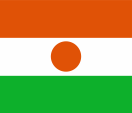
National flag,
ratio = 6:7 (?),
Source, by: Corel Draw 4






The flag of Niger was officially introduced on 23rd of November 1959. It shows three horizontal stripes in orange, white and green with a orange-coloured disk in the middle of the white stripe. The disk symbolizes the sun but also the readiness for defence of the people of Niger. The three stripes should embody the three geographical areas which Niger exists of: the abundant in grass area of the Niger River (green), the savanna (white) and the desert (orange). White stands also for the purity, innocence and harmony. More certainly is that this colours have their roots in the flag of the Ivory Coast. With it Niger was once connected. The flag is indeed nearly quadratic but it is often reproduced in format 2:3. The flag's rather peculiar format / side ratio of 6:7 is considered controversial, because the Rlag Regulation, which is in force since 1959, does not specify a format, nor is the size of the disc in the centre defined, and apart from orange and green, the colours are not specified. The hues most commonly reflected in the colour representation of the flag could be seen as Pantone 1665 for orange and Pantone 362 for green. In the times as a French colony was in use the French Tricolor.
Source: Wikipedia (DE),
Die Welt der Flaggen,
Flaggen und Coat of arms of the Welt,
Flaggen Wappen Hymnen,
Volker Preuß

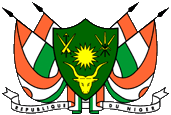
Coat of arms of Niger,
Source: Corel Draw 4

The coat of arms was introduced on 1st of December in 1962. It shows on a green shield a golden sun Tuareg swords and a spear which remember the bravery of the people in the past. Furthermore shows it millet-ears and a buffalo-head both symbols for stock-farming and agriculture.
Source:
Flaggen Wappen Hymnen

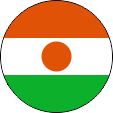
since 1980,
Aircraft Roundel,
Source, by: Wikipedia (EN)

1961–1980,
Aircraft Roundel,
Source, by: Wikipedia (EN)

Location:
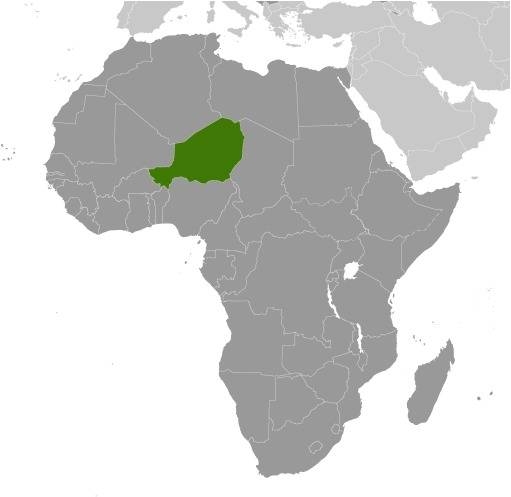
Source: CIA World Factbook
Map of the country:
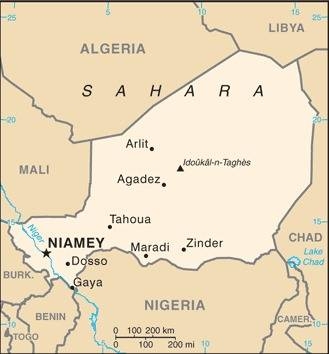
Source: CIA World Factbook

Area: 489.190 square miles
Inhabitants: 24.200.000 (2020), thereof 55% Haussa, 21% Songhai, 9% Tuareg, 8% Fulbe, 5% Kanuri and 2% Tubu, Arabs and Europeans
Religions: 99% Muslim, 1% Christian and Animist
Density of Population: 49 inh./sq.mi.
Capital: Niamey, 1.026.848 inh. (2013)
official Language: French
other Languages: Haussa, Songhai and other local languages
Currency: CFA-Franc (BCEAO) = 100 Centimes
Time Zone: GMT + 1 h
Source: Wikipedia (D),
CIA World Factbook

12th/13th century · large parts of the territory of the today’s Niger come under the influence of the State of Bornu-Kanem
ca. 1500 · large parts in the west of the territory of the today’s Niger come under the influence of the State of Songhai (Timbuctu)
1591 · Morocco conquers Timbuctu, the Songhai Empire ends
1850 · France begins with the peaceful colonization of the territory of the today’s Niger
1895 · establishment of the Government General French West Africa
1895–1896 · French troops conquer and occupy the land along the Niger River
1899–1902 · French troops conquer and occupy the southern and eastern parts of the territory of the today’s Niger
1902 · annihilation of the State of Bornu-Kanem by British and French troops
1902 · establishment of the colonial federation of French West Africa consisting of:
1st) Mauritania – French Sudan – Niger Colony – Uppervolta
2nd) Senegal
3rd) Dahomey
4th) Ivory Coast
5th) French Guinea
1906 · the French conquest of the territory of the today’s Niger is finished by occupation of the Air Mountains
1911 · the territory of the today’s Niger becomes a part of French Western Africa
1921 · formation of the Niger Colony
1932–1947 · parts of the Colony of Upper Volta are annexed to the Niger Colony
1958 · Niger becomes an autonomous republic within the French Community
3rd od August 1960 · France grants Niger full independence
1974 · military coup d’état
1990 · Tuareg riots
1991 · state reforms
1992 · new constitution
1993 · elections, victory of the opposition
1995 · armed conflicts between Fulbe and Tubu
1996 · military coup d’état, after plebiscite new presidial constitution
1999 · insertion of a civil president
2010 · military coup d’état
2023 · military coup d’état
Source:
Atlas zur Geschichte,
Wikipedia (DE)

The denomination "Niger" has its roots in the europeization of the Tuareg word for the Niger River "Egereou n-igereouen". The verbal nearness to the Latin word "niger" (→ black) was indeed a random accident but entirely welcome.
Source:
Handbuch der geographischen Namen,
Volker Preuß


![]()









